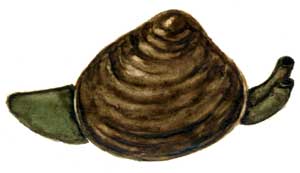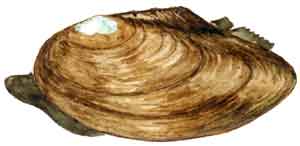Hello, Guest!
Zoological excursions
Bivalve molluscs (Bivalvia)

Fingernail clam |
Besides sponge and pearlweed, which serve as biological filter-feeders, bivalve molluscs also play an important role in purification of water bodies. At the bottom among bushes, it is easy to notice small (2 cm long) fingernail clams (Sphaerium corneum). Their body is hidden in the rounded wide shell consisting of two thin, slightly striated valves – left and right. Put the fingernail clam into the water and wait until it becomes calm. In some minutes it is possible to see that a rather long foot appears out of the half-open shell on the front end of the body, while on the back end – soft contractible semitransparent tentacles. The lower and upper tentacles are inhalant and exhalant siphons. The fingernail clam can dig in the soil not deeply. However, it prefers to slowly crawl along the stalks and leaves of large aquatic plants attached to them with mucus extracted by the foot. The fingernail clam pumps water through the shell cavity with siphons and filters food – the smallest algae, bacteria and detritus particles.

Swan mussel |
Larger bivalves – swan mussels (Anodonta piscinalis) – with a greenish-brown or brown shell inhabit the bottom of large well aerated lakes. Their valves are attached to each other with an elastic plate – ligament. Their surface is striated. Clear, slightly rugose annual lines correspond to winter stasis of the shell. It is possible to determine the age of the shell by a number of these lines.
At the bottom, molluscs vertically dig in the sand with the front part of their body. Their foot stretches out and fixes in the soil. Contracting their muscles, molluscs pull the body to their foot, thus leaving a track in the form of a shallow groove. They move very slowly – less than 1 cm a minute. One swan mussel can infiltrate 40 litres of water cleaning it from bacteria and other suspensions. The swan mussel oviposits in autumn. Its eggs develop in the female’s gill cavity till June when larvae are thrown into the water. They attach to the fish skin and live on it for almost a year until they are mature enough to live their own life.
Copyright © 2005-2010 ЦНИТ ИГУ, 

Дизайн web-студия ЦНИТ ИГУ



